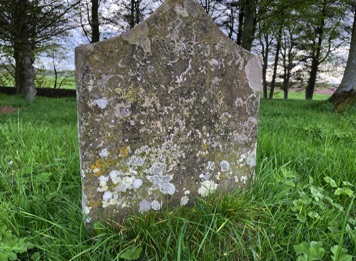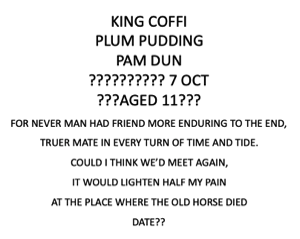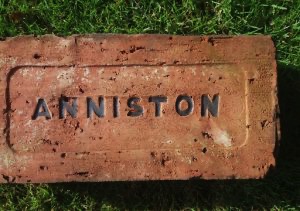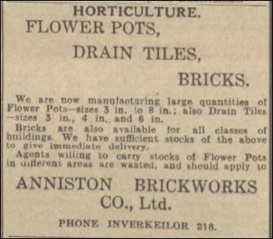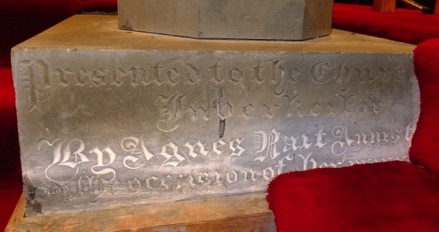A Horse with a Name
One of the interesting aspects of genealogy research is that there is always something new waiting to be discovered! In this case it concerns the Raits of Anniston - though the new information is mainly just of academic interest since their family line has long since died out.
I was contacted via the website by Ian McHaffie who was writing a book on Greek monumental inscriptions in Fife and the North of Scotland - having previously done one for Edinburgh. Under the section on Inverkeilor, Ian had included a description and translation of Greek on the gravestone of John Rait, born about 1623, a son of William Rait, the 8th laird of Hallgreen). John was minister first in Montrose and then from 1650 the parish minister at Inverkeilor, remaining there until his death in 1685, aged about 62 (see Religious Raitts). Ian also included the Greek inscription on a font donated to the church in Inverkeilor by Agnes Rait of Anniston on the occasion of her marriage in 1862. Agnes Rait of Anniston was born on 16 October 1848, married on 7 October 1862 and died in 18 January 1982.
Although Ian interests were not really the Raits of Anniston, we did exchange snippets from local newspapers which had information about the family. Usefully, because more newspaper articles have been digitized and made available online over the past couple of years or so, then I will be updating the Anniston Raits (as well as other) pages in due course with some new material.
In one newspaper story, the fact that the Rait family traces its descent from Sir Archibald Rait…killing the Thane of Caddell…fleeing to the Mearns - rather than Sir Alexander is perpetuated! But it was another “fact” that caught my eye “By the tree-embowered road leading to Anniston Mill there is a tombstone erected to the memory of a horse - “King Coffee” - formerly the war charger of Col. James Arthur Rait’s father who served in the Crimea.” Now on the Military Raitts page, I have Arthur John Rait - eldest son of James Rait of Anniston - but I don’t have a James Arthur! Arthur John was apparently at the capture of the fortress at Bomarsund during the Crimean War, but this seems to have been a naval battle rather than a cavalry charge! But James Rait of Anniston was in the Hussars and Lancers - so was the horse his? - though he does not seem to have been in Crimea. To sow even more confusion, the Arbroath Herald for December 1932 alluding to Anniston House and its estate says “In the same park, not far from the roadway, a memorial is erected to a war horse called “Major” used in battle by the father of the late Col. Arthur James Rait.”
Starter questions - was the horse called King Coffee or Major? Or were there two horses belonging to different Raits each with a memorial in the grounds of Anniston House? I do believe that the Arbroath Herald reporters were a little confused not only with the names of the horses, but also the names of their owners, as well as the facts!
In a recent note to me, Ian McHaffie mentioned that he was going up North to look for more Greek inscriptions on tombstones and I asked him, if he was anywhere near Inverkeilor, to see whether he could find the gravestone of the horse King Coffee. In due course, Ian sent me not only an image of the gravestone, but also a transcription he had made of the inscription.
The name turns out to be King Coffi and I surmised the horse was named after King Coffi Kallicalli who was defeated in the Ashantee War in which Major (then Captain) Rait of Anniston played a large part with his artillery (known as Rait's Artillery). The other names on the gravestone are either those of his other horses or perhaps the lineage of King Coffi. The extract at the bottom of the stone are the first few lines from a lament by G. J. Whyte-Melvill (1821-1878) - a Scottish novelist and poet who took a break in the 1850s to serve as a volunteer officer (as a Major) in the Turkish irregular cavalry in the Crimean War. He and Major Rait may have known each other - possibly from Crimea if the latter was really actually there, or perhaps from hunting or horse meets. In fact, Agnes Rait's brother James, and his son Arthur John, both being cavalry men, were keen horse riders and there were frequent references in the press to prizes won by James's steed King Coffi. For instance, it was reported in the South Wales Daily news for 20 March 1876 that in the Royal Artillery Drag Hunt Steeplechase, King Coffi, 6yrs, 14st, ridden by Major Rait, came 2nd.
However, the horse may not have actually been his war horse! In October 1875 there was a big sale of weight-carrying hunters and other horses, one of which was the property of Captain Rait of Anniston, Arbroath. Also for sale was King Koffee, a dark brown gelding 15.2, rising 6 years old, very handsome, first rate harness horse, single or double, quiet to ride or drive - the property of J. Wolfe Murray, Esq of Cringletie, Peebles. So I think it likely that Captain/Major Rait bought the horse at this sale, and what is interesting is that it may have belonged to another cavalry officer in Ashantee who named it after the defeated king. Subsequently I found that James Wolfe Murray was in the Royal Artillery and saw action in the Fourth Anglo-Ashanti War - though this was long after Captain Rait was there. However, his same-named father was a Brigadier General and would have been a contemporary of Captain Rait, though I can't find too much about his career.
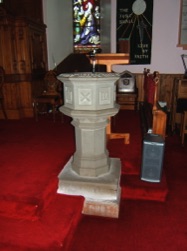
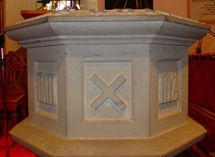
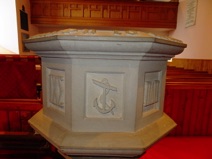
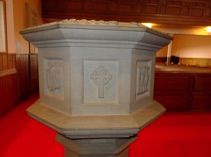
All this led me to another interesting fact - the Anniston Estate in Inverkeilor had a brick and tile works! It was noted in 1938 that the Inverkeilor district owed much to its prosperity to the far-seeing eye of the late Colonel James Rait of Anniston who saw the possibilities of his estate over a century ago. Already well-known, the brick and tile works was advertized to be let in 1860 and subsequently went through a number of different changes of ownership before undergoing voluntary liquidation in 1977.
